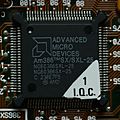- This page was last modified on 17 October 2025, at 10:18. Suggest an edit.
x86 facts for kids
x86 is a special term for a type of CPU (the "brain" of a computer). It describes a set of instructions that these CPUs understand. This instruction set was first used by the Intel 8086 chip and has been used by all its newer versions, like the famous Pentium processors made by Intel and other companies.
Most desktop and laptop computers you see today use x86 CPUs. Many powerful workstations and servers also use them. The original x86 design in 1978 could handle 16 bits of information at a time. In 1985, Intel made it better with the i386 processor, which could handle 32 bits. Later, in 2003, AMD introduced the Opteron processor, which could handle 64 bits. Intel followed with its own 64-bit versions in 2004.
A great thing about x86 CPUs is that they are "backward-compatible." This means a newer 64-bit x86 CPU can run older programs and operating systems made for 16-bit or 32-bit CPUs. Also, a 32-bit x86 CPU can run 16-bit programs. When a computer starts, x86 CPUs begin in a simple 16-bit mode. Then, the operating system quickly switches the CPU to a more advanced 32-bit or 64-bit mode to run modern programs.
Contents
What are x86 Processors?
The x86 family of processors has grown a lot over the years. They are often grouped by how many bits of information they can process at once. This includes 16-bit, 32-bit, and 64-bit versions.
Early 16-bit x86 Chips
These were the first x86 processors, handling 16 bits of data at a time.
- 8086
- 8088
- 80186
- 80286
Intel's 32-bit x86 Processors
Intel made many popular 32-bit x86 CPUs. These chips were very common in computers from the late 1980s through the early 2000s.
- i386 (also called 80386)
- i486 (also called 80486)
- Pentium
- Pentium Pro
- Pentium 2 (or II)
- Pentium 3 (or III)
- Older versions of the Pentium 4
- Pentium M
- Core
- Older Xeon
- Mobile versions of Intel Atom
- Older Celeron
Intel's 64-bit x86 Processors
These are Intel's modern processors, designed to handle 64 bits of data. They are found in most new computers.
- Newer Prescott Pentium 4
- Pentium D
- Core 2
- Core i3, i5, i7, and i9
- Newer Atom
- Pentium dual core
- Newer Celeron
- Newer Xeon
AMD's 32-bit x86 Processors
AMD is another big company that makes x86 processors. They also created many 32-bit chips that competed with Intel's.
- AMD386
- AMD486
- AMD586
- Am5x86-P75 (this was actually a powerful 486 CPU)
- K5
- K6/K6-II/K6-III
- Athlon
- Athlon XP
- Duron
- Sempron
- Geode
AMD's 64-bit x86 Processors
AMD was the first to release 64-bit x86 processors for regular computers. Their Opteron chip started the 64-bit era for x86.
- Opteron
- Athlon 64
- Phenom
- Phenom 2
- FX
- Sempron
- APU A4/A6/A8/A10/A12
- APU Athlon
- APU Sempron
- Ryzen
- Epyc
Other x86 Processors
Many other companies have also made x86-compatible processors over the years.
- Cyrix 386/486S/DLC, 5x86, 6x86, MII, MIII (all 32-bit)
- IDT Winchip (32-bit)
- Rise (32-bit)
- NxGen (32-bit)
- Via C3 and C7 (all 32-bit)
- Via Nano (64-bit)
Operating Systems for x86 Computers
Many different operating systems have been made to run on x86 processors. Some were designed only for x86, while others were adapted from different computer types.
- Only for x86: These operating systems were created specifically for x86 processors.
* MS-DOS, IBM PC-DOS, DRDOS and FreeDOS * XENIX, SCO XENIX, SCO OpenServer * Novell NetWare * SCO UNIXWare * OS/2 * ReactOS * Mac OS X 10.6-10.8 (Apple switched to x86 for these versions) * DragonFlyBSD
- Started on x86, now on others: These operating systems began on x86 but can now run on different types of CPUs too.
* Microsoft Windows * Linux * FreeBSD, NetBSD, OpenBSD
- Adapted for x86: These operating systems were originally made for other computer types but were later changed to work on x86.
* Mac OS X 10.4-10.5 (Apple started using x86 for these versions) * Solaris
Images for kids
See also
 In Spanish: X86 para niños
In Spanish: X86 para niños



